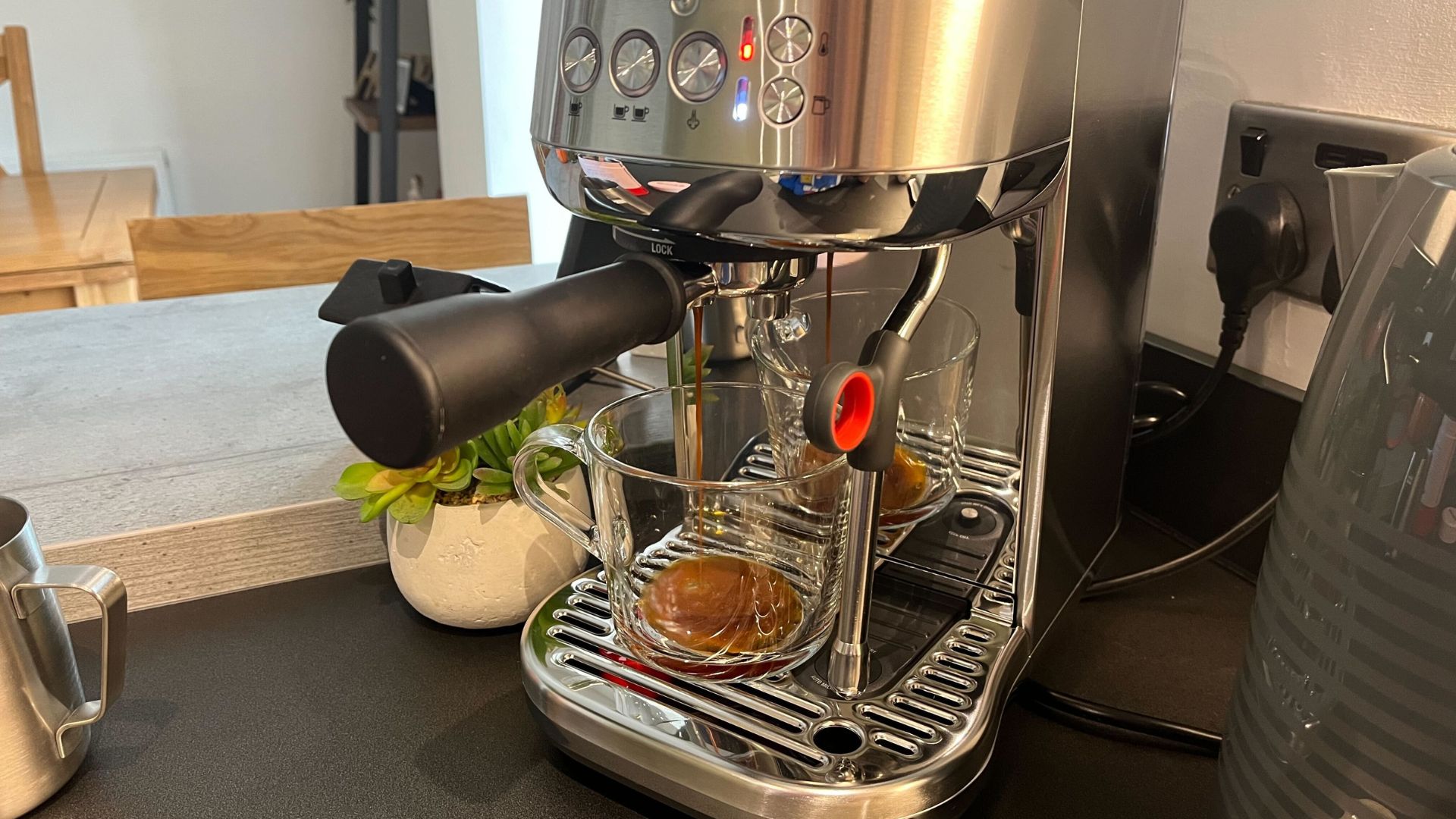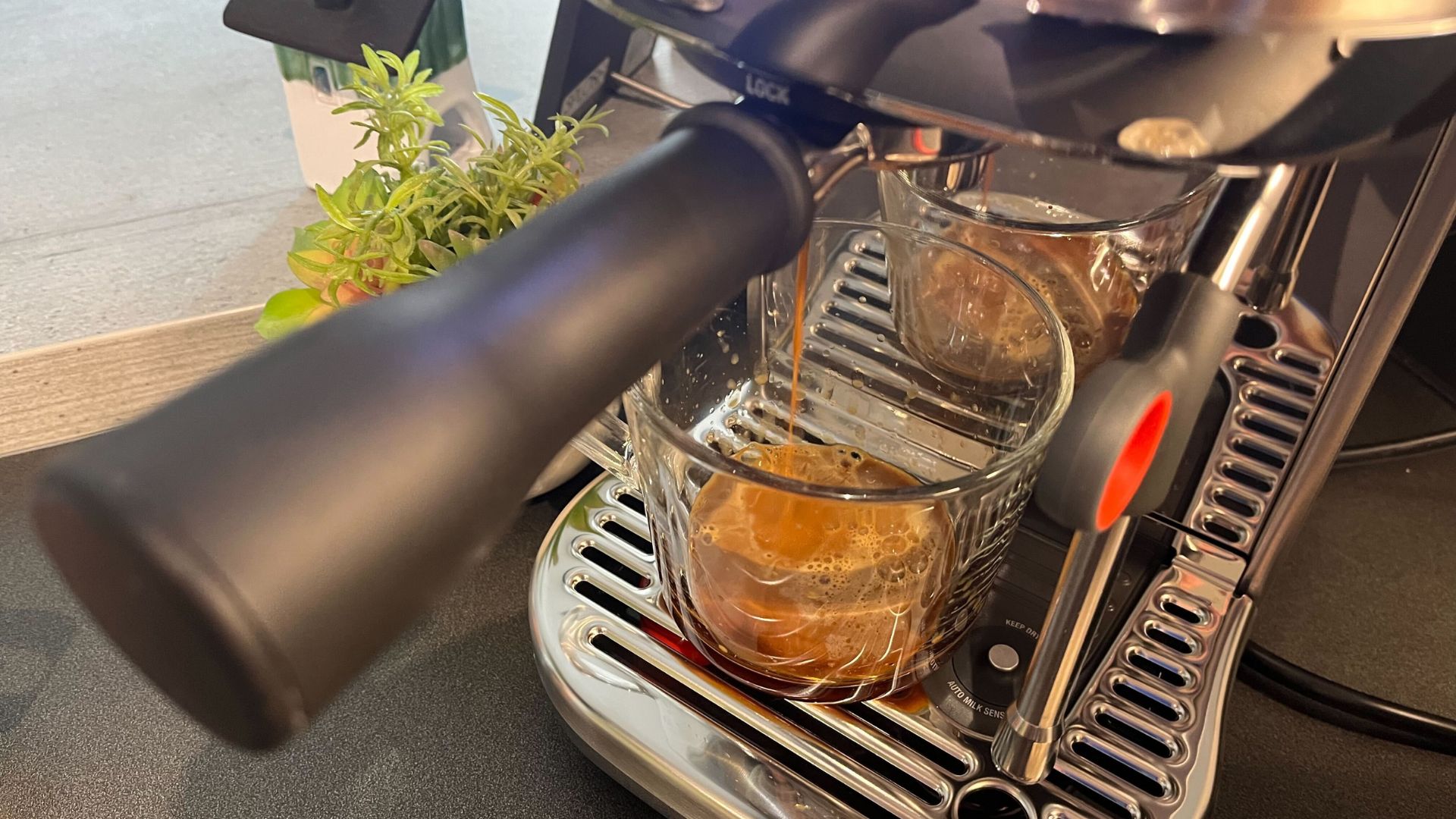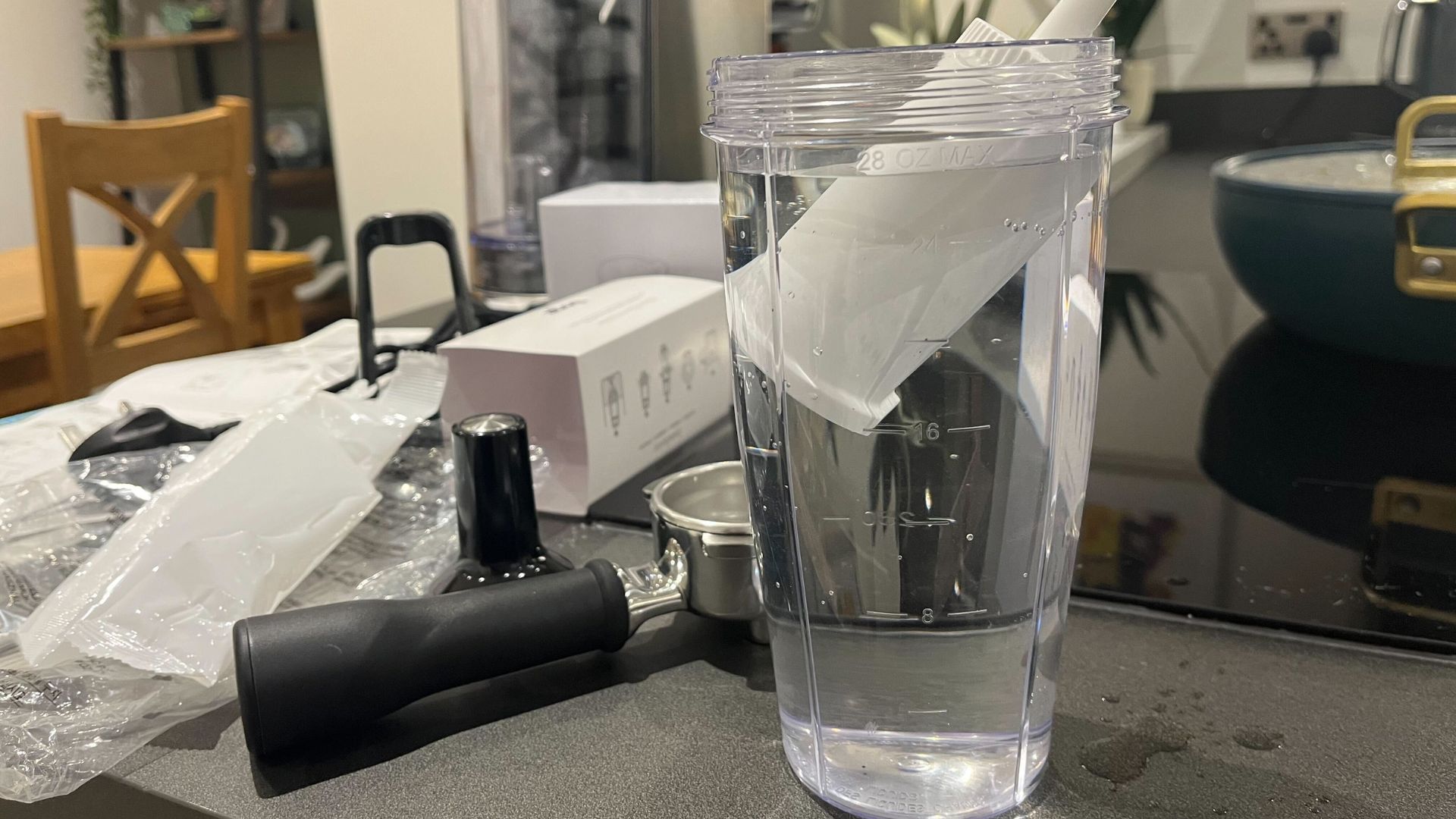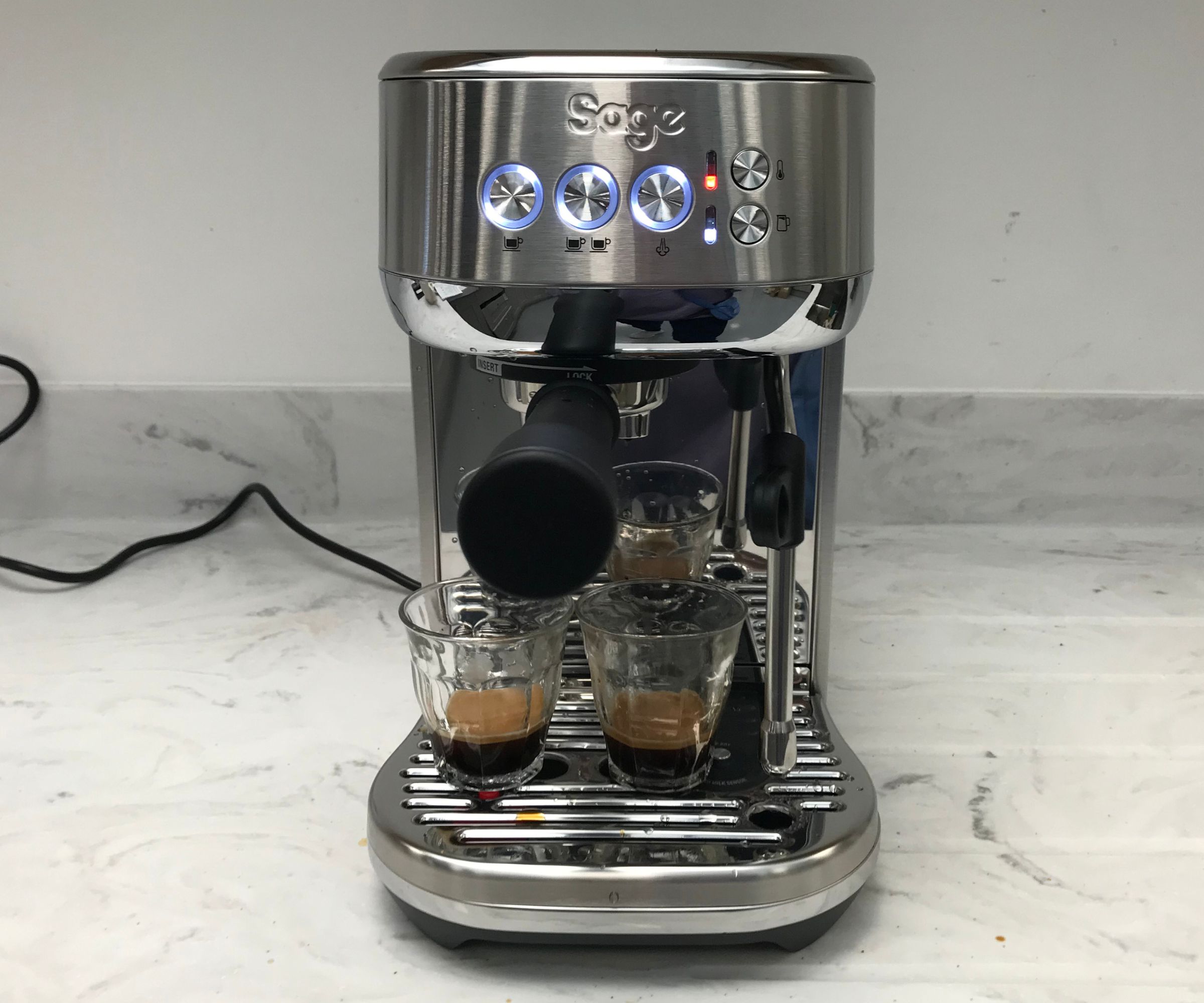I've finally found the perfect coffee machine - it's a Sage and is one of the cheapest espresso machines you'll find
This is one compact coffee hot shot

The Bambino Plus is easily one of the best espresso machines on the market and it's definitely the best value for money. This will brew delicious coffee and the automatic steam wand will help beginners to achieve perfect results without much practice. Some people might prefer the Bambino's manual steam wand, but generally, this is a great buy.
-
+
Best value espresso machine on the market
-
+
Ultra high-tech system can heat up in 3 seconds and stays hot after steaming
-
+
Makes delicious coffee (you can pre-infuse grounds)
-
+
Small footprint suits smaller homes really well
-
-
Automatic steam wand isn't as sensitive on non-dairy milks
-
-
Fixed brew head can make tall travel cups difficult to squeeze in (and low small cups messy)
-
-
Bambino (not plus) is cheaper and has more manual controls
Why you can trust Woman & Home

The most talked-about, universally loved, and strangely unassuming coffee machine of all time is the Sage Bambino Plus. It's heralded by famous baristas, local baristas, and home baristas for its top-quality coffee brewing and you'll probably (definitely) love it too.
I should start by saying that this isn't an advert for the Bambino Plus. As a former barista and home coffee enthusiast, I try to be critical of even the best coffee machines as much as I can, but Sage has made my job very tricky.
The Bambino Plus promises to be a compact machine that can brew top-quality coffee and it delivers on that. You might not have a touchscreen to scroll through or an integrated grinder, but those luxuries come at a high price point that this doesn't have. I recommend this to more people than any other espresso machine on the market. Here's why.
Specifications

| Dimensions | 7.7 x 12.6 x 12.2 cm |
| Weight | 6.65 kgs |
| Material | Stainless steel |
| Extraction pressure | 9 bars |
| Portafilter | 54 mm |
| Water tank capacity | 1.9 L |
| Power | 1600 watts |
Unboxing

The Sage Bambino Plus comes in a relatively dense, but small, cardboard box, so it's easy to lift onto the counter for unpacking. Alongside your shiny new espresso machine, Sage sends a generous selection of accessories:
- 54mm stainless steel portafilter: this feels robust (and it is)
- 1 & 2 cup single and dual wall basket: to put in your portafilter for shots of coffee
- Tamper: an essential for your compacting your coffee grounds in the portafilter
The above are pretty essential for making coffee, so I would expect every espresso machine to come with them. Sage's have enough weight to feel convincingly premium, without making them taxing on the wrists or difficult to use. What I really like is all the extras that Sage sent, without needing to:
- Razor dosing tool: for compacting your coffee grounds perfectly
- Swiss water filter: to prevent scale built up
- Cleaning tool: for limescale and dried-up milk
- Cleaning disk: for even more maintenance
- 480ml stainless steel milk jug: you'd be surprised at how many brands make this an extra cost
I've done a quick calculation of what those extras in the second 'nice to have' list would cost if you bought them on Amazon and it's well over £60. Given that the Bambino Plus is already a reasonably priced espresso machine, this is very generous. I thought the stainless steel finish was just extra shiny, but maybe it was a real halo.

Aside from the extras, it's good to know how this looks in person. If you do any research on the Sage Bambino Plus, you'll have seen that everyone likes to describe this as petite, compact, small, tiny, perfect for small spaces — or any assortment of those adjectives. I have to agree. This has all the professional aesthetics and shiny stainless steel finish of the best espresso machines on the market. The rumours are true too: it is very compact, but I would qualify this by saying that it's small for an espresso machine. There are lots of other small coffee makers on the market. The AeroPress or a French press will take up just a small section of your cupboards or drawers, whereas this is big enough to warrant some real estate on your work surface. It's worth it.
Sign up to our free daily email for the latest royal and entertainment news, interesting opinion, expert advice on styling and beauty trends, and no-nonsense guides to the health and wellness questions you want answered.
Who would it suit?

It's rare that I recommend an espresso machine to beginners and baristas like, but this has a really broad appeal. The reasons that it's great for people who are new to coffee are three-fold: it's inexpensive (for an espresso machine), simple to use, and it brews good coffee.
If you compare other espresso machines that are £400, you won't get very far. None of these will have the technical capabilities of the Bambino Plus: it warms up in three seconds, it textures milk automatically, and it uses a ThermoCoil heat system which means that using steam won't slow your machine down.
The control panel is as simple as two buttons (for one or two shots), a steam button, a temperature button, and a milk button. If you've never made coffee before, this is the least overwhelming interface you'll ever come across. I actually prefer the tactile buttons to a screen too: you know you've definitely pushed them in.
The final reason that appeals to beginners (the part about coffee tasting good) is also why it's a barista favourite, although the price tag helps them too. This uses low-pressure pre-infusion and 9 bars of extraction delivered by a 15-bar Italian pump to extract exceptionally good flavours. Your coffee will be packed with flavours (even if you use cheaper beans), the notes will be clear and perfectly extracted, and the pre-infusion will ensure each shot is smoother and sweeter than you could make it anywhere else. It's a coffee geek's dream.
What is it like to use?

I've already touched on the interface, so I won't repeat myself. The whole process is really straightforward and Sage sends an instruction manual to help you to get set up.
It's important that you fill the water tank up, make sure to use the water filter that Sage sends (or filtered water) and then run the Bambino Plus through on a couple of cycles to clear out any factory dust and dirt. You'll only need to do this for the first use: all the other times, you can turn on the machine and it'll be ready to go in minutes.

Test 1: espresso

An espresso is the building block of all things coffee, so it's important that your machine can do this right. Luckily, the Bambino Plus can extract little, delicious shots that could have come straight from heaven. My only qualm is that you can't adjust the drip tray, so your small espresso shot glasses could sit quite low on the machine, causing a little backsplash. This isn't a regular occurrence. In fact, I hardly experienced it, but shot glasses come in all shapes and sizes. If yours are particularly low, prepare for a little more maintenance.
I have a coffee grinder at home, which means that I could grind my beans freshly (and finely) for this test. However, you might want to buy pre-ground beans or a coffee grinder to go with your machine. The portafilter can hold a good 10 grams if you're doing one shot or 18 grams if you're making a double shot.
Over the course of a few months, I made what must have been over 150 shots of coffee and the Sage Bambino Plus never let me down. I used my speciality dark roast beans, my cheap beans, my decaffeinated beans, my pre-ground coffee from the shops and every shot was perfect. Extraction time never ran over 30 seconds, normally sitting closer to the twenty-second mark. I could always see a thick, hazelnutty crema (a sign that your coffee oils have been well-extracted).
The perfect temperature for an espresso is 93 °C and experts would normally say that a shot should be about 44ml. As you might expect, the Bambino Plus is almost always spot on. I never had a burnt, over-extracted, or under-extracted shot. Any issues that I had were when I played around, making mistakes that the average coffee drinker might, such as using a grind that's too coarse, tamping too loosely. You (hopefully) won't do that. As long as you follow the instructions, you'll get perfect coffee.
Test 2: Americano

An Americano is essentially a diluted espresso: you just add water. However, lots of espresso machines can over or underheat their hot water, which will make your coffee taste bitter. Not the Bambino Plus.
You’ll get your hot water from the steam wand, you just have to press a button to switch it from the steam to the water setting. This will then come out in a thin, strong jet, so make sure it’s well-positioned in your mug to avoid any splashing. I’ve measured that the water is around 90 °C, which is perfect for coffee. Experts recommend serving Americanos around 90-94°C, if you want your coffee notes to be unaffected, hot, and still drinkable.
You get control over how much hot water you add to your drink. After eight years as a barista, I'm pretty good at judging this by eye. Depending on the strength that you want and the size of your cup, aim for a 120-250ml cup of coffee. This will take the water jet around 20 seconds, at most. You'll have hot water instantly and, because there's no boiler (Sage uses a ThermoCoil system), you won't have to wait for the machine to heat back up before brewing your next drink. The one thing you can't do is brew an espresso and use the steam wand at the same time, but this is relatively common amongst espresso machines.
Overall, the Americano was as flawless as you would expect. The water infused with my espresso to give a delicious cup of coffee. All the nutty, chocolatey notes that I got in my espresso shot were just as clear and delicate in my Americano.
Test 3: Latte

Lattes, cappuccinos, and flat whites are also riffs on espressos: you take all the coffee notes and temper them with some sweetened, warm, creamy milk. Sounds simple? It's not. Texturing milk is often the place where people (and machines) trip up). It's nothing that a few YouTube videos and some dedicated practice can’t fix, but you actually don't even need to worry about that. The Sage Bambino Plus automatically steams milk for you.
Before we get into things, it’s worth noting that this is where the Bambino and Bambino Plus differ: the cheaper Bambino requires you to hand steam your milk, whilst the Plus lets you select the texture or 'frothiness' of your milk and it'll take care of the rest. Lots of people who are new to coffee prefer leaving the Plus to do the hard work, but it's worth noting nonetheless.

Back to the Bambino Plus. The steam wand takes care of everything. I put my (dairy) milk into the stainless steel pitcher and set it running. Unlike other, more advanced, espresso machines, the wand only moves forwards and backwards, not in 360 (like the cheaper Bambino), so you’ll have to work out a routine of how you insert your jug. It’s fiddly if you’re used to more flexible machines, but probably not a problem for most people.
After sitting the tip of the steam wand under the milk, I set the machine running. The whole process is relatively loud (I measured 81 dB on my noise app), but it only takes a minute to make the perfect latte and cappuccino milk. This has the microform that makes the milk taste smoother and silkier than milk that’s been whisked or aerated.
I could adjust the frothiness of my milk really easily, creating flat whites, cappuccinos, and lattes pretty effortlessly. My one issue came with non-dairy milks. If that’s not you, keep on scrolling — the Bambino Plus is extra perfect for you. However, if you like an oat milk latte or an almond milk flat white, take note. This automates texturing milk based on the temperature and reaction of dairy milk, which means that, whilst you may be able to achieve frothy plant-based milks, if you leave the steam wand to its own devices, you’ll likely end up with milk hot enough to burn your tongue. My advice is to halve the frothing time, add a temperature sticker, and try to hand-froth the milk (on the manual setting). That way, you won’t overheat and split your plant-based milks. It’s more of a hassle and means that you don’t get the extra benefit of the Plus (you’re better off saving money and buying the Bambino instead of the Bambino Plus).
Cleaning, storage, and maintenance

After you’ve frothed your milk, dairy or non-dairy, you can lower the steam wand. At this point, it’ll squid out a jet of water. This is to clean the pipes of milk, so that it doesn’t dry and clog your coffee machine. It’s a really useful feature, but if you’re not prepared or you haven’t angled the steam wand properly, if can be quite messy in the kitchen. Emily, one of our other experts, recommends keeping a kitchen towel nearby.
Aside from giving the steam wand's exterior a wipe down after use, I'd recommend emptying the portafilter of old coffee, clearing out the drip tray, and running some water through the system (as if you're making coffee, but without the grounds). This will stop any stale coffee grounds or milk from festering in the system, giving your brew a bitter or 'off' flavour. If you need more advice on how to clean a coffee machine, our experts have you covered over on our dedicated page.
How does it compare?

I’ve already started comparing the Sage Bambino Plus to the Sage Bambino, because it's impossible not to. Both machines look almost identical in size and finish. Having tested both, I’d say that the coffee that they make is almost identical too, so why would you pay more for the Plus?
The Bambino Plus is more expensive for a few reasons: it automatically steams milk rather than relying on your manual skills and it will automatically purge the steam wand after use (keeping it cleaner). For some, the Plus' automated functions make milk texturing more simple, so it's worth the splurge. For others, it's nice to have the cheaper machine, because it gives you better control over the frothing process (as we saw with the plant-based milks.
The Plus also has a slightly bigger footprint, because it has a bigger water tank (the plus is 1.9L, whereas the Bambino is 1.4L) too. It's still really compact, but if you're agonising over every millimetre of space in your kitchen, it might be worth opting for the Bambino. Aside from that though, both machines have the speedy ThermoJet heating system, they're both reasonably priced, and they both make great coffee.

If you don't want to hear about budgets and the other Bambino and you're instead looking for something snazzier, look no further than the Sage Oracle Jet. This expert gives you a menu of different milk options (dairy, oat, soy, almond), different temperatures, textures, brewing styles, and more. It's a machine that compacts all the best baristas you've ever visited into a stainless steel box. Whilst it's bigger and over £1,000 more expensive, if you don't want to puzzle over your morning cuppa, this is the one to opt for.
Should you buy it?

If you can't already tell, I think that the Sage Bambino Plus is a pretty special espresso machine. It's inexpensive, compact, and technically perfect. You get to enjoy all the advanced ThermoJet and pre-infusion technology that Sage has developed for their £2,000 machines, but you only pay 25% of the price and you need a lot less space. For all the non-dairy drinkers and experienced baristas, you can save even more money by opting for the Bambino. However, if you're new to coffee and looking for a helping hand, the Plus' automated milk steaming will be a godsend. Get ready for next-level caffeination.
How we test

At woman&home, the process for how we test coffee machines is meticulously thorough. I'm a former barista, so I like to set high standards for what our coffee machines need to live up to. If you want to get geeky, I like a 44ml espresso that's 92°C with a thick crema and deep colour. My Americanos should be 120-250ml, 91°C, with a light crema, and all milky coffees should have the glossy look of wet paint. Of course The flavours for each coffee should be distinct, delicate, and delicious. There's a high bar, but I want you to enjoy the best kind of coffee, so I'll never recommend anything that I wouldn't use.
That might sound a bit technical, but I live in a household of people who drink coffee like it's water. I know it's just as important that your coffee machine is easy to use, simple to clean, and attractive too. In my review, I cover all these points, whilst also comparing the coffee machine to other models, so that you get a good sense of what else is on the market. I talk about value, unboxing, accessories and more, so that you get a holistic idea of what the coffee maker will be like in your home. If you have any more questions after reading the review, please don't hesitate to email me. I'm always happy to chat about all things coffee.

Laura is woman&home's eCommerce editor, in charge of testing, reviewing and creating buying guides for the Homes section, so you'll usually see her testing everything from the best dehumidifiers to sizing up the latest Le Cruset pot. Previously, she was eCommerce editor at Homes & Gardens magazine, where she specialised in covering coffee and product content, looking for pieces tailored for timelessness. The secret to her heart is both simplicity and quality. She is also a qualified Master Perfumer and holds an English degree from Oxford University. Her first editorial job was as Fashion writer for The White Company.